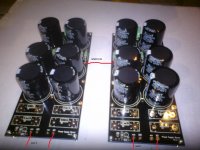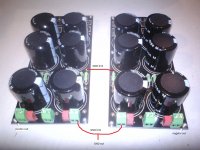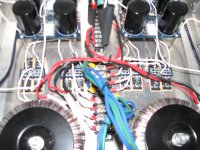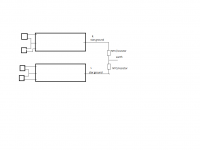I meant voltage. Like: Voltage Rating: 300 Volts from: RN60D10R0FRE6 Vishay/Dale | Mouser
aha. dont mind the voltage. you will never come close to the limit anyways🙂
a chassis that is worth a 300 EUR? Nice...
Maybe next year 🙂 This year I'll try to figure out something cheaper and local 😀
Thanks again for help, guys and good night :]
Maybe next year 🙂 This year I'll try to figure out something cheaper and local 😀
Thanks again for help, guys and good night :]
The chipamp PSU board is quite nice. Here is a photo of it with a 400VA transformer in a F5 I built -
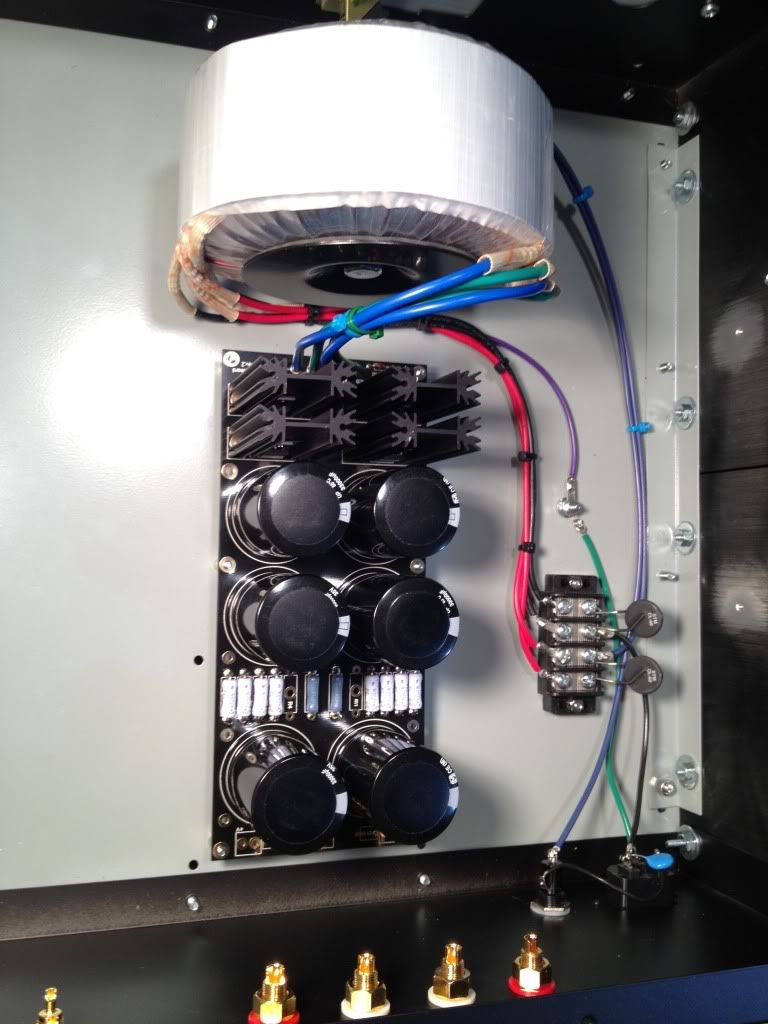
Don't go insane on the amount of capacitance. 15,000 - 20,000uf per cap (x12) is a bunch!!!!
Do get 35A TO-220 diodes. They must have heatsinks. It's probably easier (although more expensive) to use the PCB bridge instead of external bridges.

Don't go insane on the amount of capacitance. 15,000 - 20,000uf per cap (x12) is a bunch!!!!
Do get 35A TO-220 diodes. They must have heatsinks. It's probably easier (although more expensive) to use the PCB bridge instead of external bridges.
6l6, post a grounding schematic of your single rectifier in your dual mono assembly.The single bridge works great and fits on the PCB. It's a very clean installation.
Tell us the hum measurement on the output to allow us/me to assess if it is worth copying.
The arrangement of ground and single rectifier is copied from the Aleph amps.
Nelson did it it this way, I believe it is worth copying. It is also the way that it's connected natively to that particular PCB.
It has no audible hum on the outputs, and if I remember, the next time I get my hands on the amp I will scope out what residual, inaudible hum there might be.
I would suggest that if you want to assess it's suitability for your use, you should try it yourself and see what you think. It's quite nice. Are you building an F5?
Nelson did it it this way, I believe it is worth copying. It is also the way that it's connected natively to that particular PCB.
It has no audible hum on the outputs, and if I remember, the next time I get my hands on the amp I will scope out what residual, inaudible hum there might be.
I would suggest that if you want to assess it's suitability for your use, you should try it yourself and see what you think. It's quite nice. Are you building an F5?
but you dont get dual rectifier if you use the onboard diodes🙂
Just use two separate power supplies....could make dual mono, but will need another transformer. That's how I did my F5, except with Peter Daniels power supply boards and rectifier boards...
Russellc
Last edited:
well. you can. but thats more expensive and hard then just use external bridges.Just use two separate power supplies....could make dual mono, but will need another transformer. That's how I did my F5, except with Peter Daniels power supply boards and rectifier boards...
Russellc
Last edited:
I used the Daniels rectifier boards with a total of 16 MUR 3060 devices. More expensive, yes, but the whole amp was under $500.00 or there abouts.
Russellc
Russellc
I used the Daniels rectifier boards with a total of 16 MUR 3060 devices. More expensive, yes, but the whole amp was under $500.00 or there abouts.
Russellc
the question was regarding chipamps PSU boards. wether to use the onboard rectifiers, or external rectifiers to get dual rectifier.
the question was regarding chipamps PSU boards. wether to use the onboard rectifiers, or external rectifiers to get dual rectifier.
Only addressing the "dual Mono" using two power supplys, could be done with two of the chip amp boards WITH on board if that suits you better, same thing. could also be done with chip amp boards wired to external like I did.
Russellc
Last edited:
Suggest you guys take a look at the Cavalli "the Power Follower" for a simple, excellent performing power supply - the Cmultiplier and the benefits of common parts, smaller caps, full bridges, etc, etc
Only addressing the "dual Mono" using two power supplys, could be done with two of the chip amp boards WITH on board if that suits you better, same thing. could also be done with chip amp boards wired to external like I did.
Russellc
the question was not about dual mono. but dual rectifier. (one bridge pr rail)
two channels amplifiers (both dual mono and conventional stereo) do not perform consistently well with regard to hum when a normal stereo source component is connected with two interconnects. A single rectifier shared between the two channels generally performs better than a pair of rectifiers each dedicated to it's channel.
Twin single rectifiers off a common pair of secondaries generally performs worse than all other versions. It's down to the multiplicity of ground loops.
I have found that dual rectifiers from their own isolated secondaries dedicated to each amplifier channel generally perform better than the other options. But I still find that a true mono block performs better than any two channel amplifier, with all the different grounding options I have experimented with.
But I am still listening out for a better way to implement two channel amplifiers.
Twin single rectifiers off a common pair of secondaries generally performs worse than all other versions. It's down to the multiplicity of ground loops.
I have found that dual rectifiers from their own isolated secondaries dedicated to each amplifier channel generally perform better than the other options. But I still find that a true mono block performs better than any two channel amplifier, with all the different grounding options I have experimented with.
But I am still listening out for a better way to implement two channel amplifiers.
two channels amplifiers (both dual mono and conventional stereo) do not perform consistently well with regard to hum when a normal stereo source component is connected with two interconnects. A single rectifier shared between the two channels generally performs better than a pair of rectifiers each dedicated to it's channel.
Twin single rectifiers off a common pair of secondaries generally performs worse than all other versions. It's down to the multiplicity of ground loops.
I have found that dual rectifiers from their own isolated secondaries dedicated to each amplifier channel generally perform better than the other options. But I still find that a true mono block performs better than any two channel amplifier, with all the different grounding options I have experimented with.
But I am still listening out for a better way to implement two channel amplifiers.
i agree with most. but one way to improve a dual mono, is to use a dedicated star ground to each ch. and let them go to earth thru a resistor or NTC.
thats what i did on my F5. like this.
Attachments
- Home
- Amplifiers
- Pass Labs
- How to build the F5
